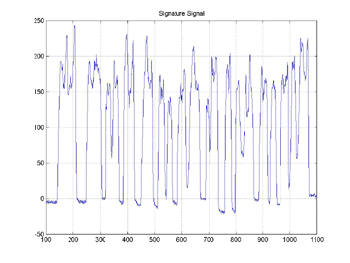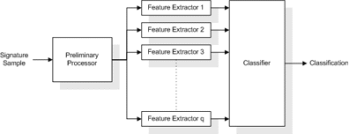Design Team Members: Ken Lee, Jen Ho, Ian Dai
Supervisor: Dr. Andrew K.C. Wong
Background
Everyday, millions of transactions take place all around the world which use signatures as a means of authentication. While these transactions rely on the fact that every individual has a unique signature, the reality is that signatures can be easily forged, resulting in costly outcomes.
Project description
The objective of this project is to design and develop a dynamic system to verify electronic signatures. The system is based on the principle that while a static image of a signature can be easily copied, it is increasingly difficult to copy the way in which that signature was signed. By capturing the process of signing (such as the motion of the pen, velocity, acceleration, pressure, etc), a unique characteristic profile can be made of that individual's signature. An example of a digitally sampled signature characteristic is shown in Figure 1.

Figure 1: Digitally sampled signature waveform of a particular signature characteristic
Design methodology
The design of the signature verification system is divided into two phases: the learning phase, and the recognition phase. In the learning phase, unlabelled signature waveform samples are processed and analyzed to determine a unique characterized pattern or profile of the individual's signature. In the recognition phase, an unlabelled signature sample is processed, analyzed, and then compared against the profile of the individual. The result of the signature verification system is the previously unlabelled signature sample classified into one of two classes: the class of authentic signatures, or the class of forgeries. An overview of this system is shown in Figure 2.

Figure 2: Block diagram overview of the system
The design methodology used for the project follows the process:
-
problem definition
-
requirements analysis
-
research of feature extraction methods and classifier system
-
algorithm and system design
-
implementation
-
testing and analysis